Common Grass species identification: Some easy shortcuts
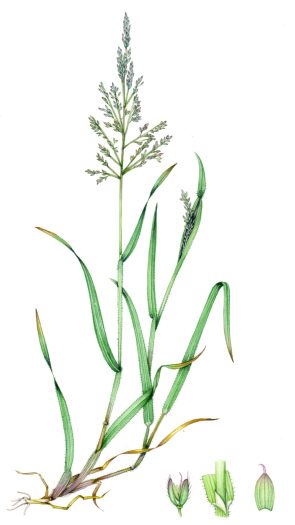
As you may have noticed, I’m rather obsessed with grasses, and have blogged on them often. From an introduction, to learning about them, to celebrating their beauty , discussing the ecological significance of Maram grass (guest blog), and more recently, to telling them from Rushes and sedges
And, of course, I do botanical illustrations of them rather frequently.
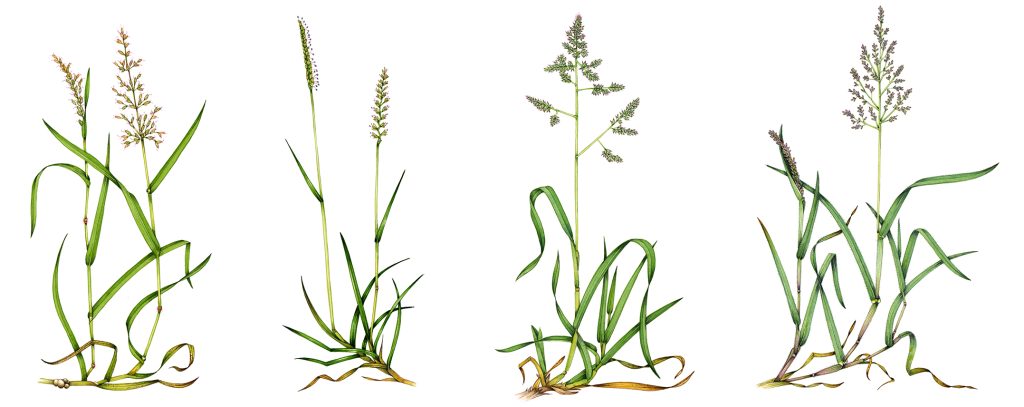
Selection of grasses
I went on an FSC course recently, this time on identifying grasses (other grass courses by FSC are available here). And one of the things I learned was some really quick tips to help identify some fairly common grasses. So I’m going to share them.
Common grasses: Cocksfoot
I think Cocksfoot Dactylis glomerata is one of the easiest grasses to learn. It forms thick clumps, and is rather blueish. Leaves are folded as they grow. They’re sometimes crinkled, as if the grass is being pushed up. But the give away is the way the flowering heads branch. They almost always have two lower branches which come out at wide angles from the stem. this explains the name as people reckon the branches look like the divergent toes of a cockerel. It grows from 15 – 140cm. The ligule is quite long, white, and looks “torn” or ripped.
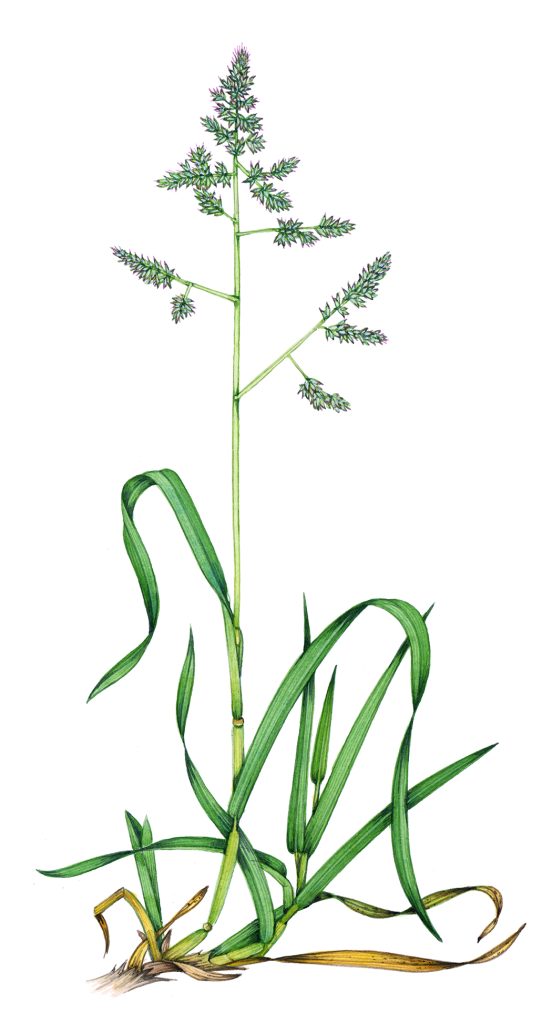
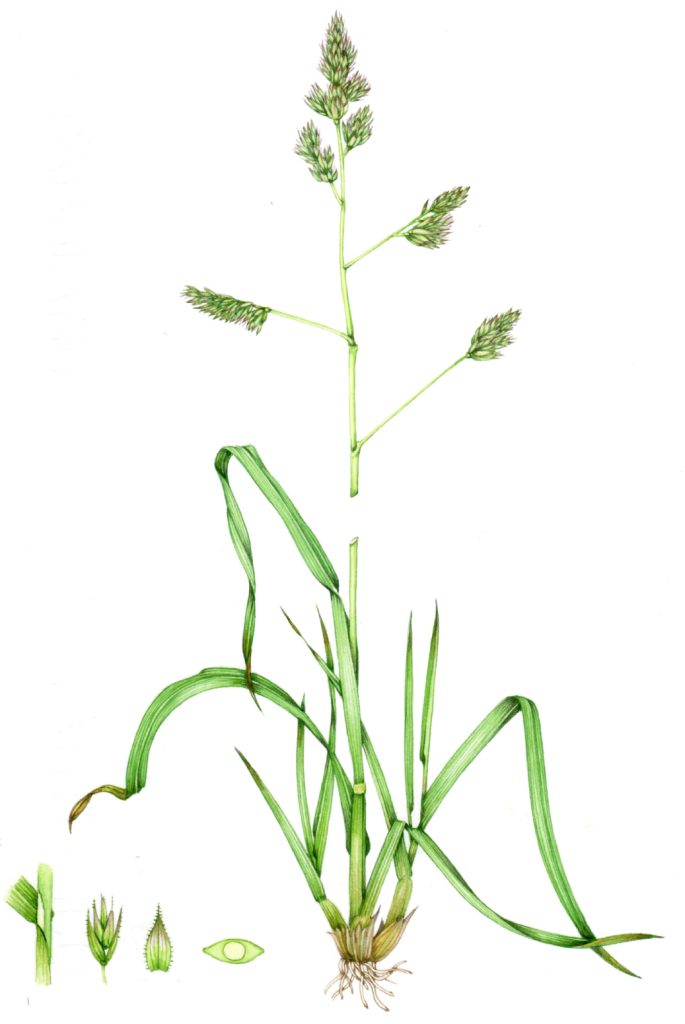
Cocksfoot Dactylis glomerata
The lower stem is often pale or even white.
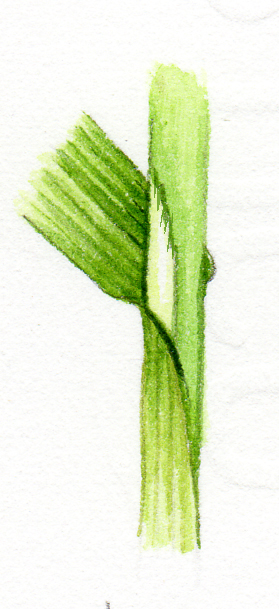
Detail of Cocksfoot ligule
My two illustrations of separate plants show this diagnostic lower branch pattern pretty clearly. The flowering spikelets are often tinged pink or purple, but be aware that this is true for quite a few grass species.
Common grasses: Rye grass
Rye grass Lolium perenne is ubiquitous. It’s planted for grazing and also makes up the bulk of grass seed for lawns. It’s incredibly tough, and will often be the grass still standing after being mown. You often see residual flowering spikes all through the winter. If unmown, it will grow to 10 – 90cm.
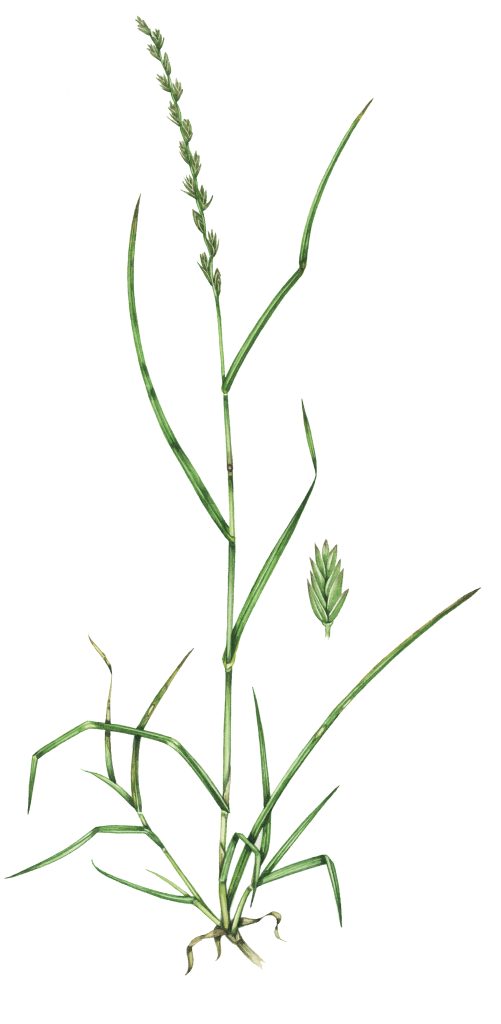
Rye grass Lolium perenne
Rye grass is really shiny green, especially when young. Unlike most grasses, its flowers cling very closely to the stem. They don’t branch out or droop. The only other species that bears its flowers in a similar pattern is the Italian Rye grass.
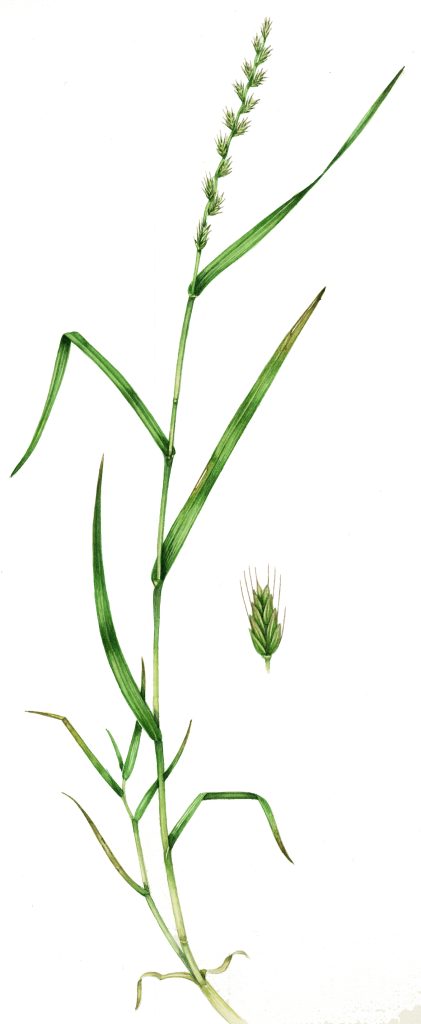
Italian Rye grass Lolium multiflorum
The main difference between these two is that the Italian rye has spines or “awns” on its spikelets. But you can see how similar the form of the flowering spike is.
Common grasses: Sweet Vernal Grass
Sweet vernal grass Anthoxum odoratum is another common grass. It’s one of the first grasses to flower. This species can grow up to 80cm high. As the name suggests, it smells rather strongly of hay. This comes from high levels of cumarin which is what gives hay its distinctive sweet smell. Crush a blade of Sweet vernal grass and, in theory at least, you should be able to smell it.
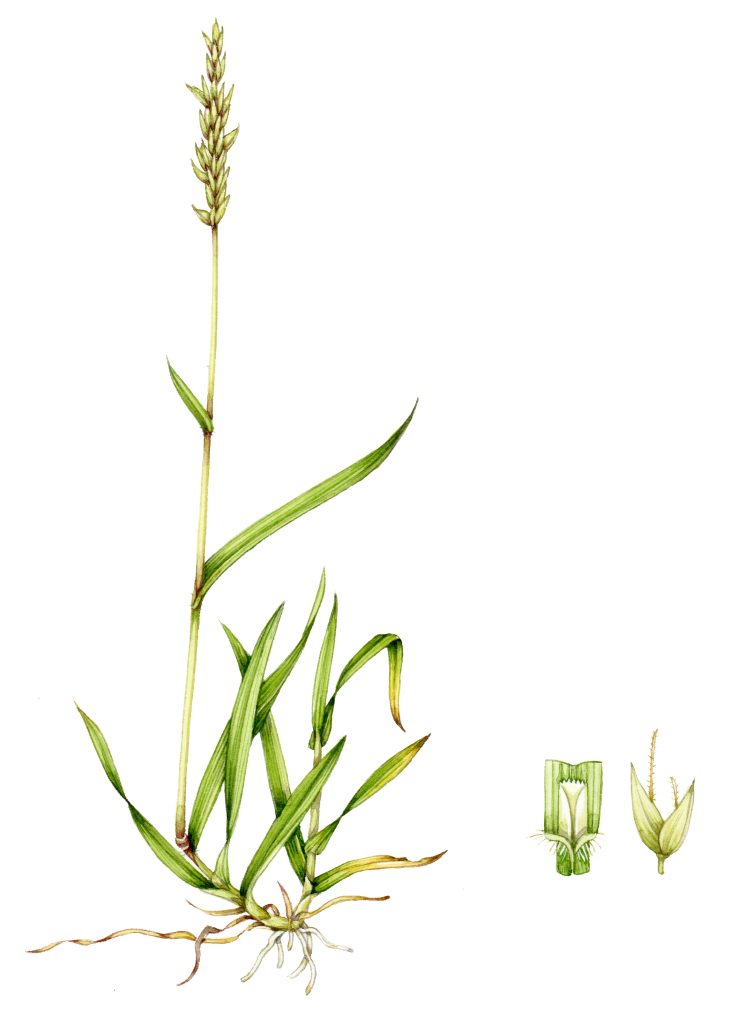
Sweet Vernal grass Anthoxanum odoratum
It also has a “beard” of hairs around it’s ligule. The only other UK grass to have a similar beard is the Heath grass Danthonia decumbens which only grows in arid places.
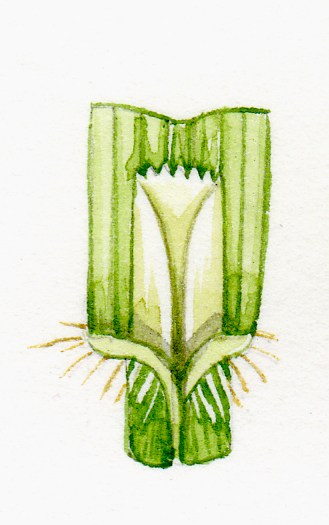
Detail of ligule of the Sweet vernal grass
Common grasses: Common Reed
Common reed Phragmites australis grows in rivers, canals, and ponds, and damp places. It has broad blue-ish leaves. It is a really big plant, growing to 2 – 3 m tall.

Common reed Phragmites australis
Reed flowers are quite easy to see too. The outer layers are often flushed maroon which gives the flowering head a purplish look, and the spikelets have long spines or awns.
The big give-away with the reed is its ligule. Unlike most grasses, it doesn’t have a membraneous one. Its ligule is a simple circle of long hairs. It’s the only UK grass that has this feature. Coupled with it’s love for moist habitats, you can recognize the Common reed with no trouble.
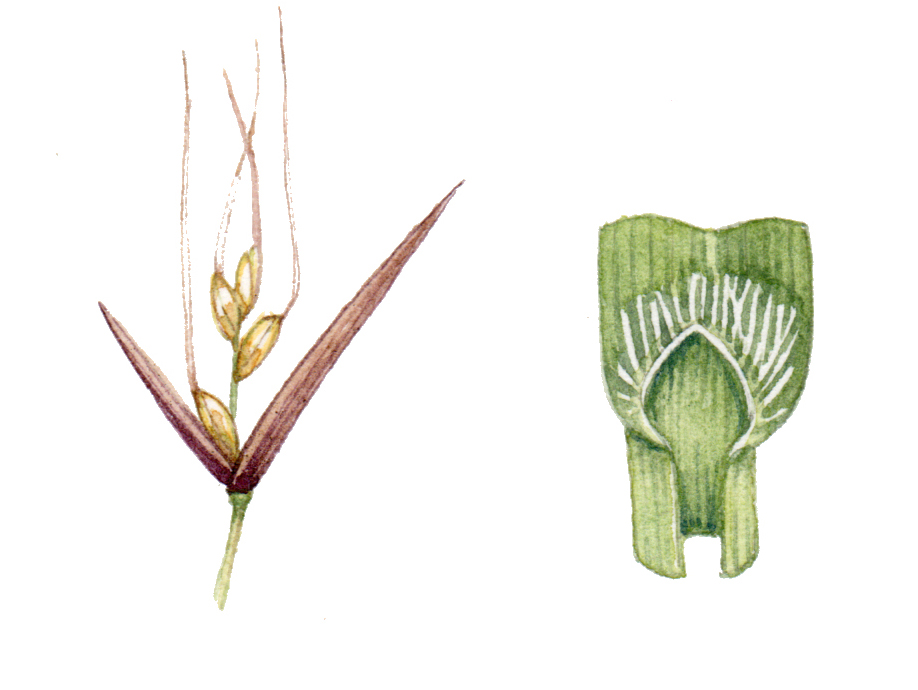
Detail of an individual spikelet and the ligule of hairs of the Common Reed
Common grasses: Yorkshire fog
Yorkshire fog Holcus lannatus is one of my favourite grasses. It feels different to almost all the other grasses (except the closely related Creeping soft grass Holcus mollis which tends to grow in woodlands not meadows), as if it’s made of incredibly fine velvet. It grows from 20 – 100cm tall.
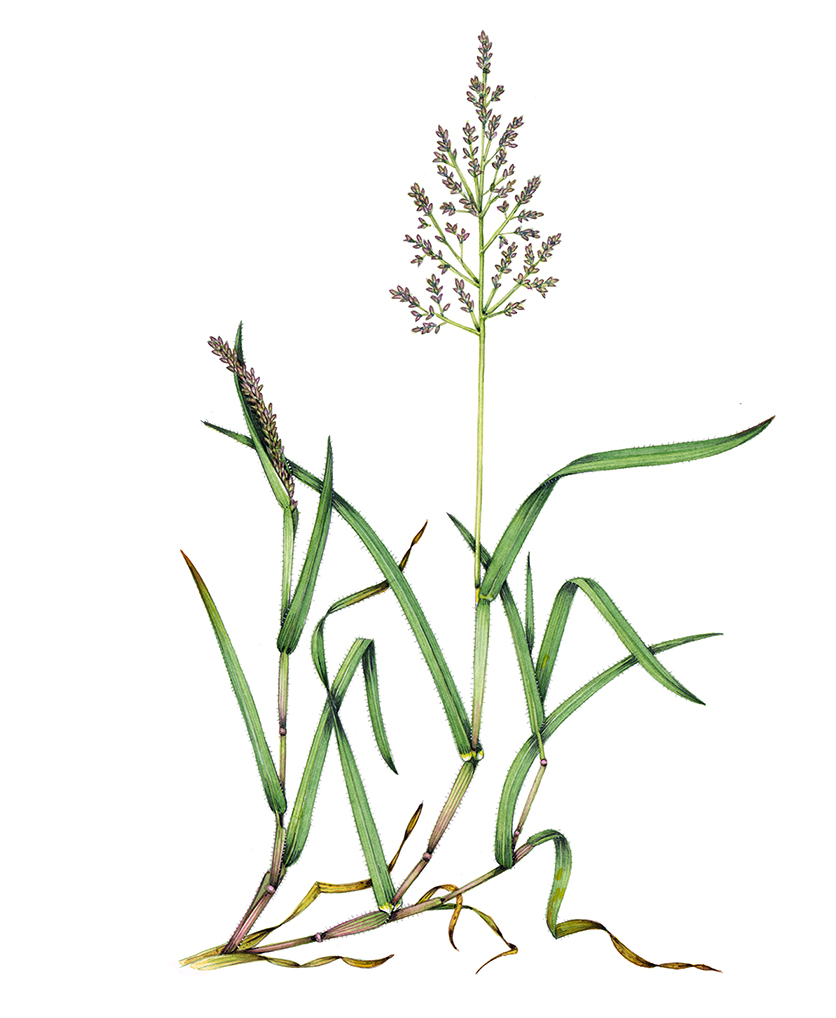
Yorkshire fog Holcus lanatus
The spikelets are often flushed a beautiful pink. It’s worth noting that the flowering spike hides inside the sheath of a leaf blade before flowering, so you often see if very compressed. Once in full flower, it has a wide spreading flowering head.
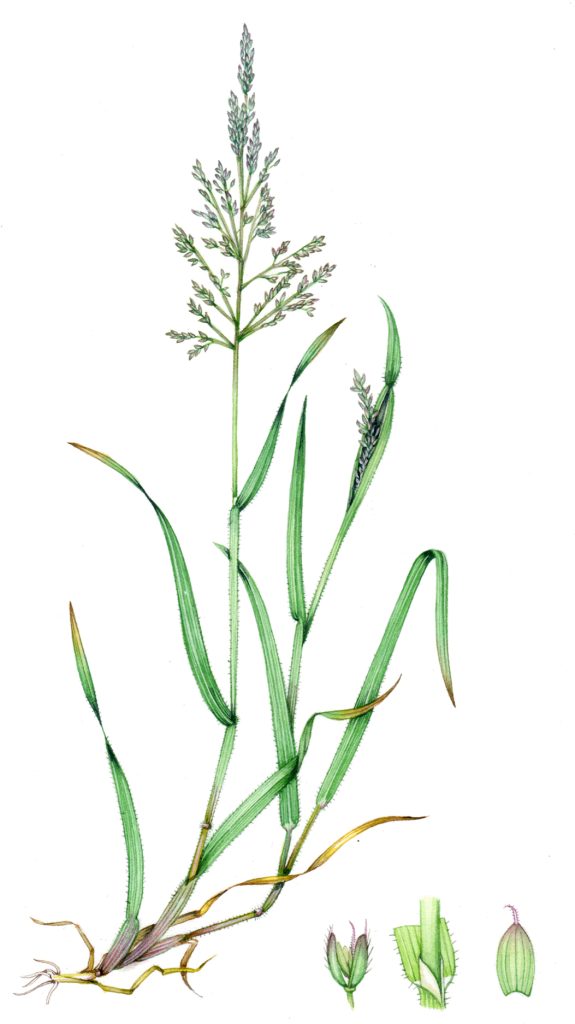
Yorkshire fog Holcus lanatus
But if this velvety texture doesn’t convince you, there’s another way to check you are looking at Yorkshire fog. Have a rummage right down at the base of the plant, and look closely at the stems. If you see pink stripes, like old fashioned pyjamas, then you’ve got Yorkshire fog. In fact, the whole plant is flushed pink, but again, that alone isn’t a species diagnostic. The pyjama stripes are.
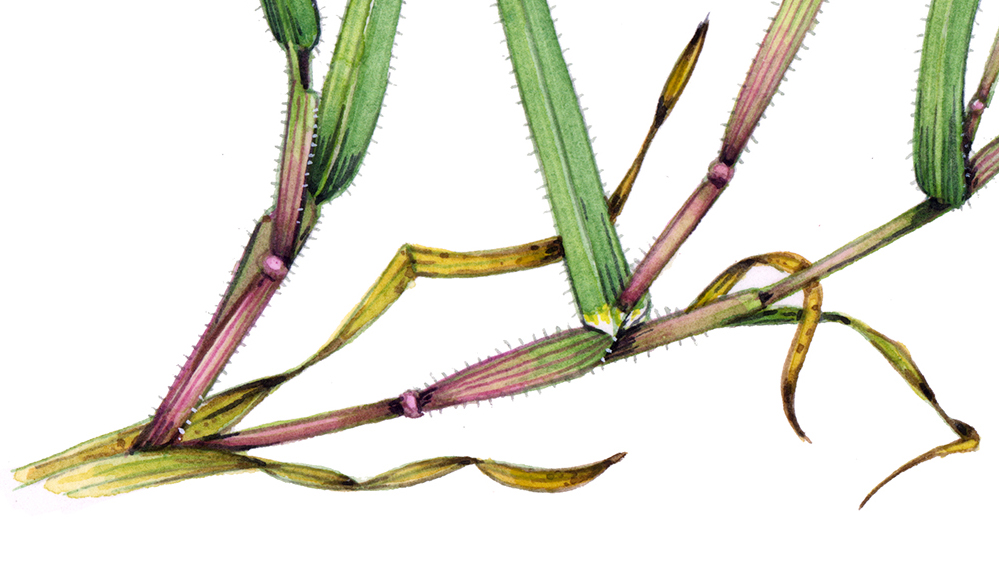
Pink “pyjama stripes” at base of Yorkshire fog
Common grasses: False Oat grass
False Oat grass Arrhenatherum elatius is everywhere. You’re very likely to find it on road verges and in recently disturbed places, or unmanaged land. It’s known as a ruderal species. Although the flowering head is branched, the branches come close together once fertilized. This makes the flowering heads look like graceful silvery arches. The leaves are flat and a dull green.
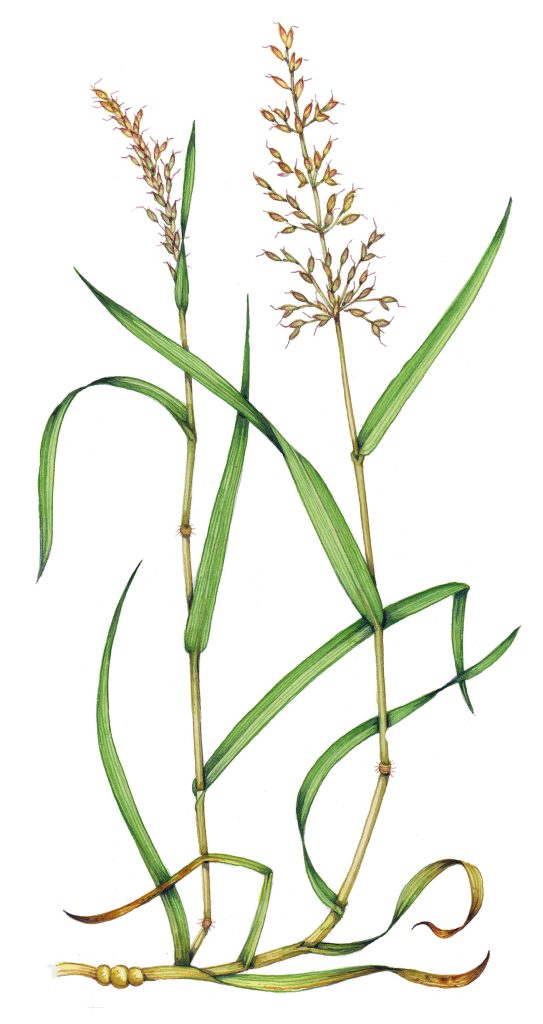
False Oat grass Arrhenatherum elatius
The spikelets have really long awns, as long as the entire spikelet. The long awns give the grass the effect of being very silvery as it catches the light. Each spikelet only holds two florets, one of which has the reproductive flowering parts. Here’s a close up of the flower, showing the distinctive long awn:
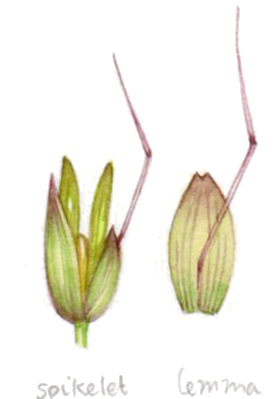
Flower and lemma of the False Oat grass Arrhenatherum elatius
But there’s one more trick to identifying False oat grass. Look at the roots. The base of this grass has yellow-orange roots. these are really distinctive, and may also be swollen into round bulb-like structures. For me, the yellow roots are the final piece of jigsaw that helps me i.d. this one right every time.
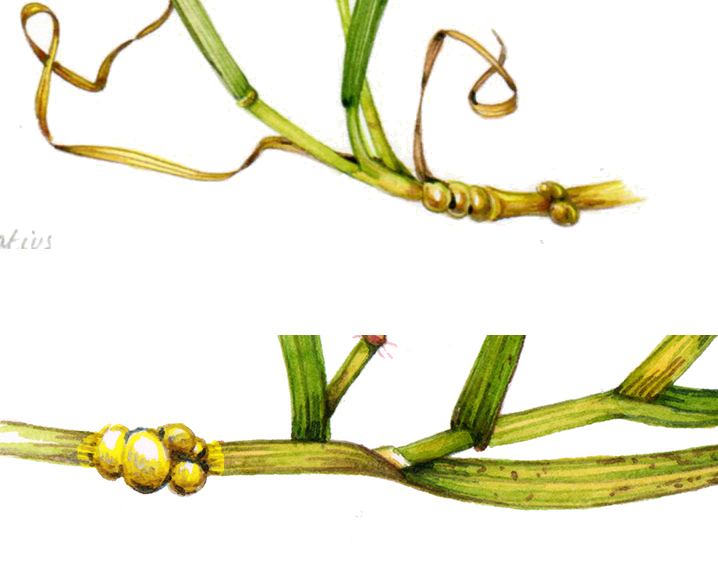
Yellow roots of the False Oat grass
Common grasses: Spotting your Meadow grasses
This is a bit of a cheat as it won’t take you to an actual specific species. But many of our UK species are Poa, or members of the Meadow grass family. So how can you tell if a grass is a Poa? It’s mostly down to the distribution of the branches on the flowering spike. If they grow in whorls, and the inflorescence is like a christmas tree in shape, then you’re likely to have a Meadow grass.
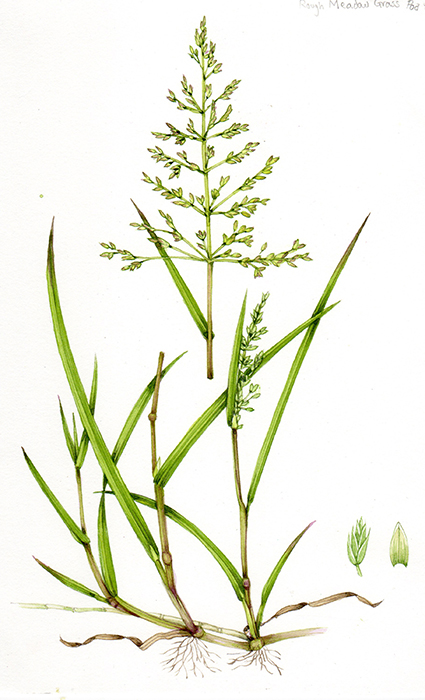
Rough meadow grass Poa trivialis
One other group of UK grasses are also whorled in growth, the Bents. However, Bent grasses (like Common or Creeping bent Agrostis capillaris) flower later in the year. They also have tiny flowers, much smaller than the Meadow grasses. Also, Bent grasses only have one floret per spikelet. Poa have many more. The meadow grass above, Rough meadow grass Poa trivialis, can be identified by rubbing the stem on your upper lip. if it’s rough, then it’s likely to be P. trivialis rather than any other meadow grass.
Meadow grasses are another of the species who have really obvious flattened and keeled leaves (like the Cocksfoot). These blades are said to be “boat shaped”, with a distinct prow. They look as if they’ve been folded in half.
Conclusion
So there you are. A whistle stop tour of some of our commonest grasses, and how to identify them. There are others that are crazily easy – the Bearded couch Elytrigia repens has extremely purple nodes (at least in woodland habitats). It has distinct claws where the leaf blade meets the stem, and very little in the way of ligules. These claws (“auricles”) are also flushed a vibrant purple. Look out for it in woodlands.
The Quaking grasses are easy too, mainly because they look so dissimilar to everything else. They tremble in the breeze, grow in dry heathland, and are one of our prettiest grasses.
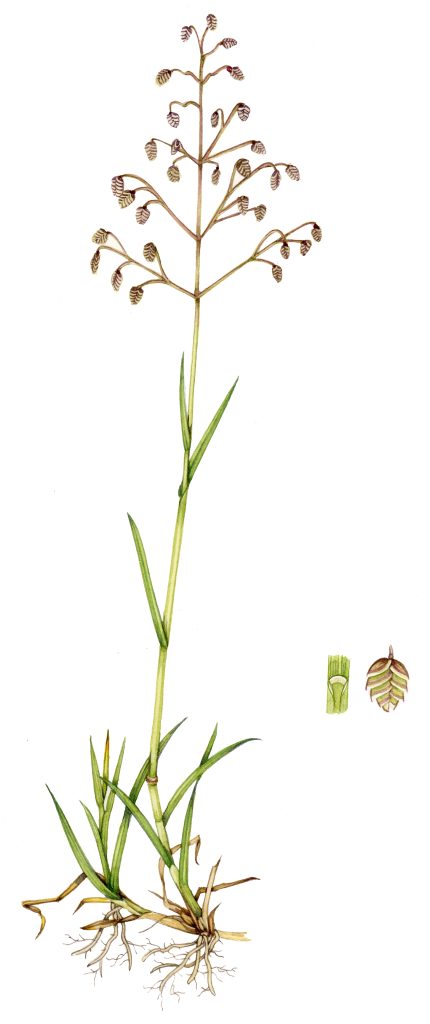
Quaking grass Briza media
And the Crested Dog’s hair Cynosurus cristatus is another one to keep an eye out for. At a push it might be confused with Rye grass, but it’s distinctive zig-zag inflorescence feels very different.
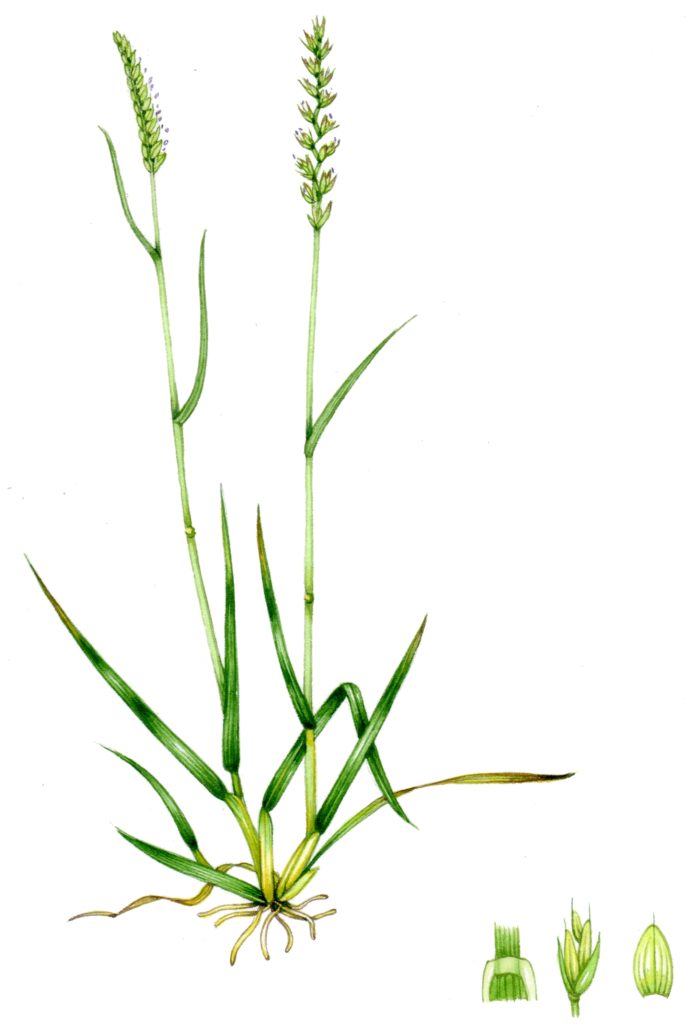
Crested Dog’s hair grass Cynosurus cristatus
I hope I’ve managed to share some of my love of these diverse and glorious plants. Not only are they fabulous and frequently overlooked, but they’re also wonderful to illustrate! Now you;re able to identify a few species, give it a go. You may well find yourself entirely bewitched by grasses, like I am.


These summaries are really useful. For the past few years I have been trying to learn some more grass species. You make it easier to focus on a specific part of the plant for I.D.
I would be grateful if you could point me to the differences between rye grass and couch grass, please. Do you cover that on a previous blog post?
Hi Eleanor. Hmmm. Rye grass I can do. Its got these single florets either side of the flowering stem, alternately placed: https://lizzieharper.co.uk/2013/06/glorious-grasses/lolium-perenne-and-lolium-multiflorum-botanical-illustration-by-lizzie-harper/. The Couch grass is similar, but I think (off the top of my head) that the flowers are a little larger, and the leaves are a touch broader: https://lizzieharper.co.uk/product/grass-common-couch/. But your best bet is to compare species notes for both in a flower guide that’s good on grasses! (Some aren’t) Sorry not to be more use. Yourss Lizzie
Hi, I have a shiny leafed grass with red base just like Ryegrass ‘cept it has rhizomes. Any ideas please?
Hi Paul
Oh man, now you’re asking. I had a quick look, and only some of the sites say that Lolium species are rhizome free. The Perennial Rye grass in my garden doesnt have rhizomes, and various online sources agree. But this rather handy article shows photos of Rye grass rhizomes! http://webidguides.com/_templates/grassgroup_ryegrass.html However, if it’s not a Rye, could it possibly be a Couch grass? These are discussed in the same article, and also turn up frequently in garden turf. Sorry not to be more use, and thanks for asking
Lizzie
This is WONDERFUL and so are your beautiful illustrations. Just exactly what I was using. Back to studying my grass now. Thank you, thank you!
OOh what a lovely comment! Glad to be of help
X
Greeting from U.S., western Pennsylvania! Beautiful introduction to commonly encountered grasses, which, amazingly, are grasses commonly encountered here in the ruderal parts of the northeastern deciduous forests!
That IS interesting! And I bet so many people, unlike you, never even bother to look at the grass below their feet, let alone be awed by the global reach of these wonderful plants! Thanks so much for the comment
Your drawings are just exquisite and so wonderfully detailed. I’ve always loved grasses but so struggle to differentiate them. I’m now doing a short project (as part of a course) trying to recognise the grasses in my horses’ hay – gee it’s challenging, but your drawings will hopefully help. Thank you.
Hi Alison, thanks so much for your kind comments. I love that youre doing id from horse hay – nothing lie making a job challenging for yourself! Start by seeing if you can spot easy ones, like rye grass or timothy grass and work up from that. Good luck! I think it sounds like a great project!
I am a farmer with a range of marsh and hill grass fields and keen to be able to identify the various grasses quickly. Any suggestions please?
Hi Derek
Not sure where youre based, but if you are in the Uk you could do worse than buy the BSBI book to identifying grasses by Tom Cope and Alan Grey. You could also invest in the pretty straight forward FSC guide https://www.field-studies-council.org/shop/publications/grasses-guide/ (alas, not with my illustrations; before my time and extremely good). Another option is to get in touch with your local wildlife trust who may come and do a species study for you, if they’re interested in what’s there? Or look up your “county botanical recorder”, they may be able to help as well.
Thanks for the question
Yours
Lizzie
Great article and thanks – Landscaper here based in Cardiff. Rhidian 🙂
Thanks!
Only just discovered your site. Wonderful descriptions and drawings! Thank you. I get excited this time of year as the first scented vernal grasses and meadow foxtails appear. The changing flower structures as they mature are fascinating. However it doesn’t matter how many times I crush the sweet vernal grass it never seems to offer up its scent for me! Thanks again
Hi Malcolm
Thanks so much, Im glad you enjoyed my blog. I know, the minute details of grasses is so exciting! Not sure why the vernal grass doesnt smell for you – maybe try drying it out, then take a sniff?
Hello,
I live in Virginia (USA) and have a small farm for equids & cattle (sometimes). We consider this an invasive species because it is not grazed by horses or cattle. I have fought Yorkshire fog hard for 2 years in succession and hope you can advise me as to the root depth. Some papers indicate it is deep; however, in my grubbing, using a grub hoe, and taking out 3-4 inches of soil with it, I have found no evidence of roots at any significant depth per se. I see tillers but do not observe stolons (it can grow sideways though). I often find YF grows in what I would term grass litter/duff on the pasture floor. Does ANY scientific paper indicate the root depth of this grass? I can send you hundreds of image if you think I am barking up the wrong tree so to speak. Thank you, Louisa
Hi Louisa
This is very weird. In the UK Yorkshire fog is rather a well-loved fodder crop for sheep and cattle (don’t know about horses), and is an important part of hay crops. It certainly doesn’t have deep roots, and I think you’re right that it doesn’t grow with stolons or tillers. I wonder if maybe youre fighting a different species? I’m far from an expert on grasses, but you could get in touch with the Botanical Society of Britain and Ireland https://bsbi.org/contact-us who may be able to point you in the right direction for academic research on root depths? Sorry not to be more use, Yours Lizzie